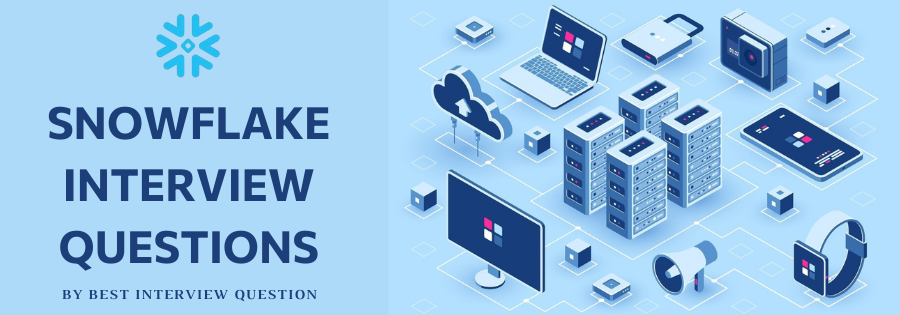
Snowflake is becoming the most popular cloud data warehouse solution because of its innovative features such as separation of computing and storage, data sharing, and data cleaning. It provides support for popular programming languages like Python, Java, Go, .Net, etc. Tech giants like Adobe systems, AWS, Informatica, Logitech, Looker are using the Snowflake platform to -intensive applications. Thus, there is always a demand for Snowflake professionals. If that is the career move you are making, and you are training or preparing for a Snowflake job interview, the below Snowflake interview questions and answers will help you prepare.
Most Frequently Asked Snowflake Interview Questions
Here in this article, we will be listing frequently asked Snowflake Interview Questions and Answers with the belief that they will be helpful for you to gain higher marks. Also, to let you know that this article has been written under the guidance of industry professionals and covered all the current competencies.
It is an analytic data warehouse implemented as a SaaS service. Snowflake has been built on a new SQL database engine with an amazing architecture built for the cloud. This cloud-based data warehouse solution was first known on AWS as software to load and analyze massive volumes of data. However, the most unique feature of Snowflake is its capability to spin up any number of virtual warehouses, which indicates that the user can operate an infinite number of independent workloads as opposed to the same data without any risk of contention.
ETL stands for extract, Transform, and Load. ETL is the method that we use for extracting the data from multiple sources and loading it to a particular database or data warehouse. These sources include third-party apps, databases, flat files, etc. Snowflake ETL is a process to apply the ETL approach for loading the data into the Snowflake data warehouse or database. Snowflake ETL also contains extracting the data from the data sources, doing the necessary transformations, and loading the data into Snowflake.
Snowflake is built-up entirely on a SQL database. Snowflake is a columnar-stored relational database that works well with Excel, Tableau, and many other tools. Snowflake has its query tool, supports multi-statement transactions, role-based security, etc., which are desired in a SQL database.
The Snowflake data partitioning is called clustering, and the table is arranged according to cluster keys. Re-clustering refers to the process of managing clustered data in a table.
Unique features of the Snowflake data warehouse are detailed below:
- Database and Object Closing
- Support for XML
- External tables
- Hive meta store integration
- Supports geospatial data
- Security and data protection
- Data sharing
- Search optimization service
- Result Caching
To gain complete knowledge about snowflake features Snowflake Training helps to a great extent .
Snowflake cloud data warehouse platform gives instant, secure, and governed access to the entire data network and a core architecture to enable different types of data workloads, including a single platform for developing modern data applications.
Snowflake helps the most common standardized version of SQL, i.e., ANSI, for effective relational database querying.
- Microsoft Azure (Azure)
- Amazon Web Services (AWS)
- Google Cloud Platform (GCP)
the best ETL tools for Snowflake are as follow:
- Hevo Data
- StreamSets
- Etleap
- Apache Airflow
Snowflake's zero-copy cloning allows us to generate a copy of our tables, databases, and schemas without replicating the data itself. To assume zero-copy in Snowflake, we include using the keyword known as CLONE. Using this action, we can obtain live data from the production and carry out multiple actions.
Data all that we enter into the Snowflake gets compacted systematically. Snowflake uses modern data compression algorithms for compressing and storing the data. Clients have to pay for the packed data, not the exact data.
Whenever we load the data into the Snowflake, it contains the data into the compressed, columnar, and optimized format. It deals with storing the data that includes data compression, organization, statistics, file size, and other properties associated with the data storage. The Snowflake stores all data objects that are inaccessible and invisible. Using Snowflake's SQL query operation, we can access the data objects.
Snowflake's Virtual warehouse is one or more clusters endorsing users to carry out operations like queries, data loading, and other DML operations. Virtual warehouses support the users with the necessary resources like temporary storage CPU for performing various snowflake operations.
There are several ways to access the Snowflake data warehouse:
- ODBC Drivers
- JDBC Drivers
- Web User Interface
- Python Libraries
- SnowSQL Command-line Client
The Snowpipe advantages are as follow:
- Live insights
- User-friendly
- Cost-efficient
- Resilience
Columnar databases differ from conventional databases. Columnar database saves the data in columns in place of rows, eases the method for analytical query processing, and offers more incredible performance for databases. Columnar database reduces analytics processes, and Columnar database is going to be the future of business intelligence.
When developing applications with Snowflake, programming may be required. JavaScript, Snowflake Scripting, and Scala are used in Stored Procedures to perform branching and looping.
Snowflake is designed for the Online Analytical Processing(OLAP) database system. Subject to the use, we can use it for OLTP(Online Transaction processing) also.
No, Snowflake does not utilize the indexes. One of the things that makes the Snowflake scale suitable for querying so well is this aspect.
The Snowflake program creates metadata automatically for files in the external or internal stages. The metadata is stored in virtual columns, and the "SELECT" statement is used to query them.
Check out for advanced Snowflake Interview Questions to crack the interview easily.